Research from McKinsey & Company shows that, in times of uncertainty, business as usual, investing in incremental changes, is actually riskier than bold innovation. But while innovating may, paradoxically, be less risky, it is not without its challenges. Companies that innovate successfully are not immune to the challenges found in innovation management. Rather, they are equipped to face these challenges head-on. This article will explore the ten biggest challenges in innovation management in 2025, as reported by executives and teams, along with tips, tools, and best practices to overcome them and unlock the rewards of innovation while avoiding the risks of maintaining business as usual.
Of course, every company and every team has different challenges at the top of the agenda this year. But at their core, many challenges in innovation management stem from the same fundamental themes of how to innovate more collaboratively and sustainably, as well as faster, smarter, and bolder.
The following list of challenges in innovation management is based on our experience with multinational clients and insights from more than 300 experts in the fields of innovation, business development, HR, R&D, marketing, and strategy across more than 20 industries.
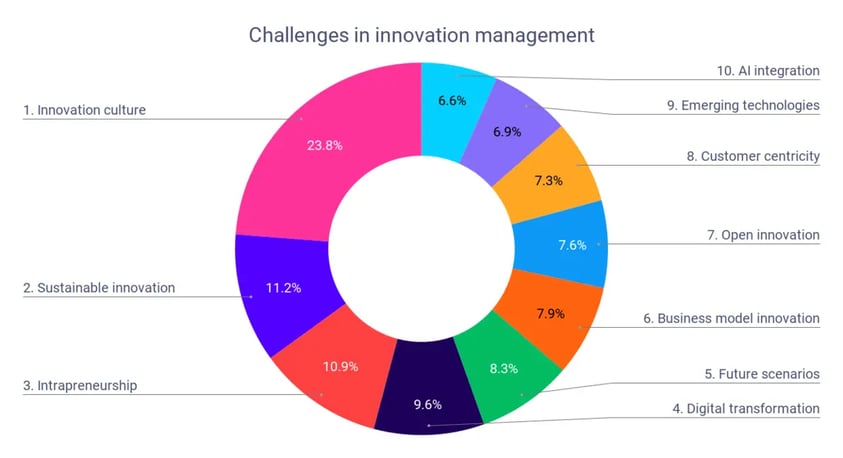
1. Innovation culture
Innovation culture represents an organization's mindset and practices that foster innovative thinking, fueling creativity and openness to new methods. This enhances the development and quality of new products and services. However, fostering such a culture is challenging, requiring a shift in operations to empower employee collaboration, idea-sharing, and risk-taking, alongside a commitment to invest in innovation and view failures as learning opportunities.
Tips to overcome obstacles in fostering an innovation culture:
- Address resource constraints: Allocate specific resources for innovation, including budget, time, and talent. This could involve assigning specific responsibilities to teams or individuals and adopting tools to help streamline and automate innovation processes.
- Reduce risk aversion: Build a culture that celebrates learning from failures as much as successes. Encourage experimentation by implementing fail-safe environments where risks are managed and failures are seen as stepping stones to innovation.
- Centralize innovation: Establishing a centralized operating system for all innovation activities enhances collaboration and transparency, helping your teams seamlessly embed continuous innovation into core practices and culture.
Sanjeev Mervana, Vice President of Product Management, Emerging Technologies & Incubation (ET&I) at Cisco, emphasizes the pivotal role of leadership in shaping an innovation-forward culture. Cisco’s approach, as he explains in the Innovation Rockstars podcast, is a top-down model that permeates through the organizational hierarchy. This method ensures that innovation is not a sporadic activity but a core element of the company's ethos.
Innovation is a continuous process. It's not something you take care of when you have a spare moment. It has to be part of your culture, it has to be deeply rooted.
Sanjeev Mervana, Vice President of Product Management, Cisco
Mervana highlights the significance of strategic planning and the concerted efforts required at all organizational levels to foster a thriving culture of innovation. The outcome, as Cisco's experience shows, is well worth the dedicated efforts, yielding considerable success and advancement.
2. Sustainable innovation
Sustainable innovation is pivotal for addressing environmental, social, and governance (ESG) issues. It involves innovating in ways that not only benefit the business but also positively impact people and the planet. However, aligning innovation with sustainability goals can be complex, given the breadth of aspects like greenhouse gas reduction, energy efficiency, and social equality.
Tips to overcome obstacles in sustainable innovation:
- Define clear sustainability goals: Align your innovation strategies with specific sustainability goals, such as those outlined in the United Nations' 17 Sustainable Development Goals.
- Integrate sustainability into innovation processes: Embed sustainability considerations into the core of your innovation processes. This integration ensures that every new product, service, or process contributes to your sustainability agenda.
- Evaluate and adapt the value chain: Regularly assess and optimize your value chain for sustainability. Understand where values are lost and gained and how innovation can enhance sustainability at each stage.
Dr. Clemens Chaskel, Industrial Associate for IfM Engage, Institute for Manufacturing at the University of Cambridge and guest of the Innovation Rockstars podcast, emphasizes integrating sustainability goals with innovation systems through roadmapping. This approach ensures that future product iterations make necessary strides towards sustainability.
By using roadmapping for your sustainable activities, we can pick up on [the SDGs] and not only understand what we need to put in place to address one of those goals, but most importantly, we can understand how we connect them with our innovation system.
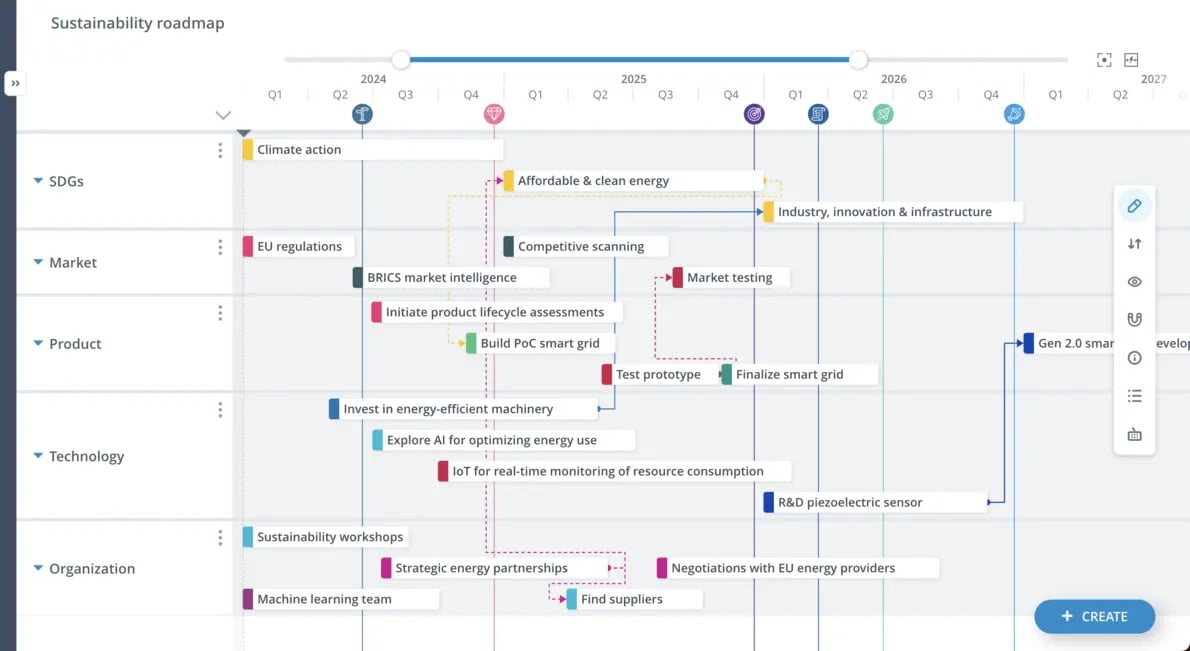
Roadmapping software can help organizations visualize and strategize the integration of sustainability goals within their innovation processes. This and other portfolio management tools facilitate identifying areas for improvement, tracking progress toward sustainability objectives, and aligning every innovation with both business and environmental targets.
3. Intrapreneurship
Intrapreneurship, fostering entrepreneurial skills and mindsets within an existing organization, is vital for driving innovation from within. It encourages employees to develop and pursue new ideas, contributing to the company's growth and adaptability. But often, due to potential conflicts with the company’s existing culture, structure, and risk tolerance, significant organizational shifts are needed to nurture and sustain intrapreneurial efforts.
Tips to build an enabling environment for intrapreneurship:
- Incentivize engagement: Develop a culture that actively incentivizes your employees for their innovative thinking and willingness to take risks. This could include gamification and reward mechanisms.
- Structured idea management: Implement idea management software for categorizing, evaluating, prioritizing, and developing ideas to streamline processes for both intrapreneurs and decision-makers in your company.
- Provide resources and support: Ensure access to resources such as funding, time, and mentorship. This empowers your employees to turn their innovative ideas into tangible projects within the company framework.
Another proven way of cultivating intrapreneurship is by creating innovation labs. An innovation lab is a dedicated space where employees can focus on developing new ideas and innovations outside their regular job responsibilities.
Hans Lind, Director of Business Innovation & Foresight at the Volvo Group, describes innovation lab best practice in the Innovation Rockstars podcast. He explains how the Volvo Connected Solutions Innovation Lab typically looks for a partner within the group who is interested in and willing to co-fund the innovation activities around a new focus area. In addition to splitting the investment and, therefore, any associated risk, the lab also gets cross-functional buy-in and accountability to deliver the best results possible.
4. Digital transformation
Digital transformation is a persistent challenge that goes beyond the demand for a well-informed technology strategy (more on that in no. 9). It involves a fundamental shift in business processes and models, affecting both internal operations and customer engagement. This transformation demands a holistic approach, integrating systematic planning and ongoing adaptability, to effectively leverage digital advancements for business growth and customer satisfaction.
Tips to smoothly navigate and adapt to the changing digital landscape:
- Develop a digital roadmap: Establish a clear digital transformation strategy, outlining short- and long-term goals. This roadmap should consider how digital technologies can enhance various aspects of your business, from operations to customer engagement.
- Leverage data analytics: Utilize data analytics to drive decision-making. Implement tools that gather and analyze data to provide insights into customer behavior, market trends, and internal processes, informing strategic decisions.
- Enable digital collaboration: Implement an innovation operating system that enables cross-functional collaboration, communication, and teamwork in a digital-centric workplace.
In the Innovation Rockstars podcast, Christian Schmitz, Senior Consultant, Innovation & Digitization at DZ Bank, discusses how the ITONICS Innovation OS is a key driver of his company’s digital transformation strategy. DZ Bank uses ITONICS to actively monitor and analyze a trend radar with over 200 identified trends while also managing current projects on an innovation radar.
Schmitz emphasizes ITONICS’ efficacy in offering a detailed view of current trends and projects, fostering an environment of open contribution, and thus driving both transparency and collaborative potential within their innovation management processes.
5. Future scenarios
Future scenarios are essential in innovation for visualizing potential futures, enabling organizations to foresee changes, spot emerging opportunities, and minimize risks. This foresight is key to proactive innovation and staying ahead of market trends. However, the unpredictable nature of the future makes scenario planning and strategic foresight challenging, requiring a blend of creativity, analytical thinking, and, increasingly, the power of artificial intelligence (AI).
Tips to effectively navigate the challenges of scenario planning and strategic foresight:
- Leverage AI: Automate environmental scanning with AI for accurate trend analysis and monitoring. This technological approach speeds up data processing and deepens insights to enhance foresight.
- Shift to long-term focus: Cultivate a strategic mindset that values long-term planning. Incorporate scenario planning into your regular strategic reviews and decision-making processes to ensure it's a core part of organizational thinking.
- Reframe foresight as a strategic necessity: Educate your teams on the critical role of foresight in business development and innovation. Make scenario planning a central aspect of the strategic planning process.
Speaking with ITONICS CEO Dr. Christian Mühlroth in our Innovation Rockstars podcast, Tessa Finlev, former Head of Foresight at Dolby Laboratories, underscores the importance of integrating strategic foresight deeply into organizational processes. Foresight demands committed effort and strategic alignment with business operations.
To assume that running a Foresight or Future program is something that people can do on the side of their regular work would doom the whole thing directly to failure.
Tessa Finlev, (Former) Head of Foresight, Dolby Laboratories
Embracing strategic foresight for future scenarios equips organizations to navigate the uncertainties of tomorrow more effectively. By leveraging AI-driven insights in the proactive exploration and preparation of potential futures, companies can make more informed decisions. This integration of technology enhances the ability to adapt swiftly to change and maintain a competitive edge in a dynamic and unpredictable world.
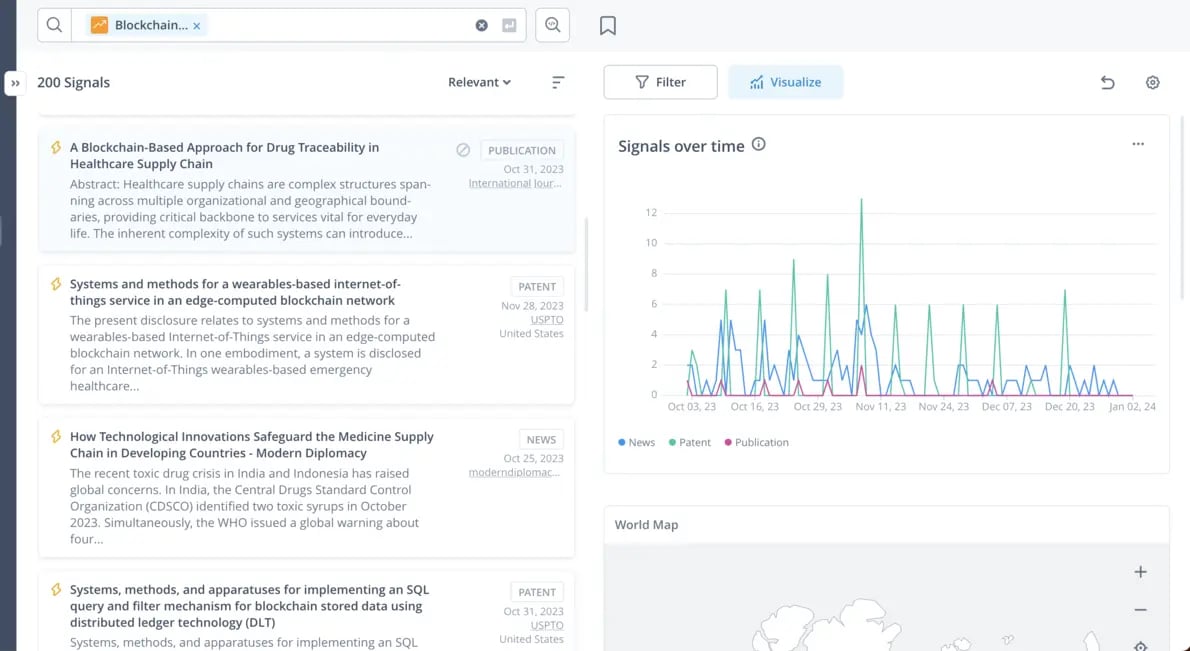
6. Business model innovation
Over the last half-century, the lifespan of the average business model has declined from 15 years to under five. Business model innovation—redefining how companies create and deliver value to customers—has come into the focus as a way to drive transformation, growth, and resilience. However, fundamentally changing value propositions or operating models for the better without jeopardizing core business represents a major challenge for many companies.
Tips to drive constructive business model innovation:
- Conduct market and consumer research: Continuously monitor, map, and evaluate market trends and consumer needs to guide the innovation of your business model.
- Pilot and iterate: Experiment with new business model elements in a controlled environment before full-scale implementation. Use feedback from these pilots to validate, refine, and improve the model.
- Build a balanced portfolio: Use portfolio management software to prioritize, validate, and execute new business model innovations while continually improving existing products and ensuring alignment with your strategic goals.
In addition to these recommendations, Manuel Krauß, Senior Consultant of Business Model Innovation at Bosch Innovation Consulting, emphasizes the importance of protecting new ventures that arise out of business model innovation from the constraints of the core business.
In the Innovation Rockstars podcast, Krauß explains this strategic separation can be achieved by establishing a dedicated organizational structure for business model or Horizon 3 innovation, allowing it to still tap into the company’s assets, like market power and sales channels. He also warns against burdening these new ventures with heavy KPI targets too early, as they are often initially based on assumptions rather than established facts—which is why piloting and iterating is so important for successful business model innovation.
7. Open innovation
Despite gaining popularity in the 2000s and being well-recognized as an effective method for enhancing the diversity, number, and success of innovations, open innovation is still cited as a significant challenge in many companies. Indeed, the challenge is less because of buy-in or understanding the benefits of open innovation and more about the execution. Adopting open innovation increases complexity and, when not managed systematically, securely, and with clear goals, can increase risk and waste resources.
Tips to effectively tackle the challenges in open innovation:
- Establish clear collaboration frameworks: Create transparent, well-defined collaboration guidelines. This helps align your goals, manage expectations, and integrate external ideas into internal processes.
- Leverage digital platforms: Utilize an open innovation platform to streamline the process of sourcing, managing, and collaborating on ideas, making it easier to handle the influx of external contributions.
- Protect intellectual property: Develop clear strategies for intellectual property management. This includes setting boundaries for collaboration and ensuring everyone’s interests are protected, balancing sharing ideas with safeguarding proprietary information.
 By establishing the system and structures for open innovation, a company can invite proposals from startups and potential partners and direct input from customers. Open innovation also allows for supplier-driven innovation in which a company and its suppliers exchange knowledge, ideas, and technologies. Suppliers are shown to have a high potential for impacting innovation due to their existing relationship with and understanding of the company—that is, their customer.
By establishing the system and structures for open innovation, a company can invite proposals from startups and potential partners and direct input from customers. Open innovation also allows for supplier-driven innovation in which a company and its suppliers exchange knowledge, ideas, and technologies. Suppliers are shown to have a high potential for impacting innovation due to their existing relationship with and understanding of the company—that is, their customer.
DMG MORI, one of Germany's largest manufacturers of cutting machine tools, integrated its suppliers into the innovation process using the ITONICS Innovation OS. To empower supplier innovation on a global scale with a geographically dispersed supplier base, DMG MORI opted for our collaborative, fully configurable, and easily scalable solution.
8. Customer centricity
It’s obvious: put your customer at the core of your innovation activities. And yet, when innovations fail—and indeed, a vast majority do—it is often due to a lack of market research and consumer insights. Essentially, many companies launch new products or services for which there is no market, no customer demand.
Tips to foster customer-centricity in innovation:
- Involve customers early: Engage your existing and prospective customers in the innovation process from the beginning to ensure their needs and feedback guide development.
- Apply design thinking: Incorporate design thinking principles, which focus on empathizing with customers and iterating solutions based on their feedback and experiences.
- Continuously monitor trends: Use automated monitoring and analytics tools to streamline the identification of important signals related to customer trends and behaviors.
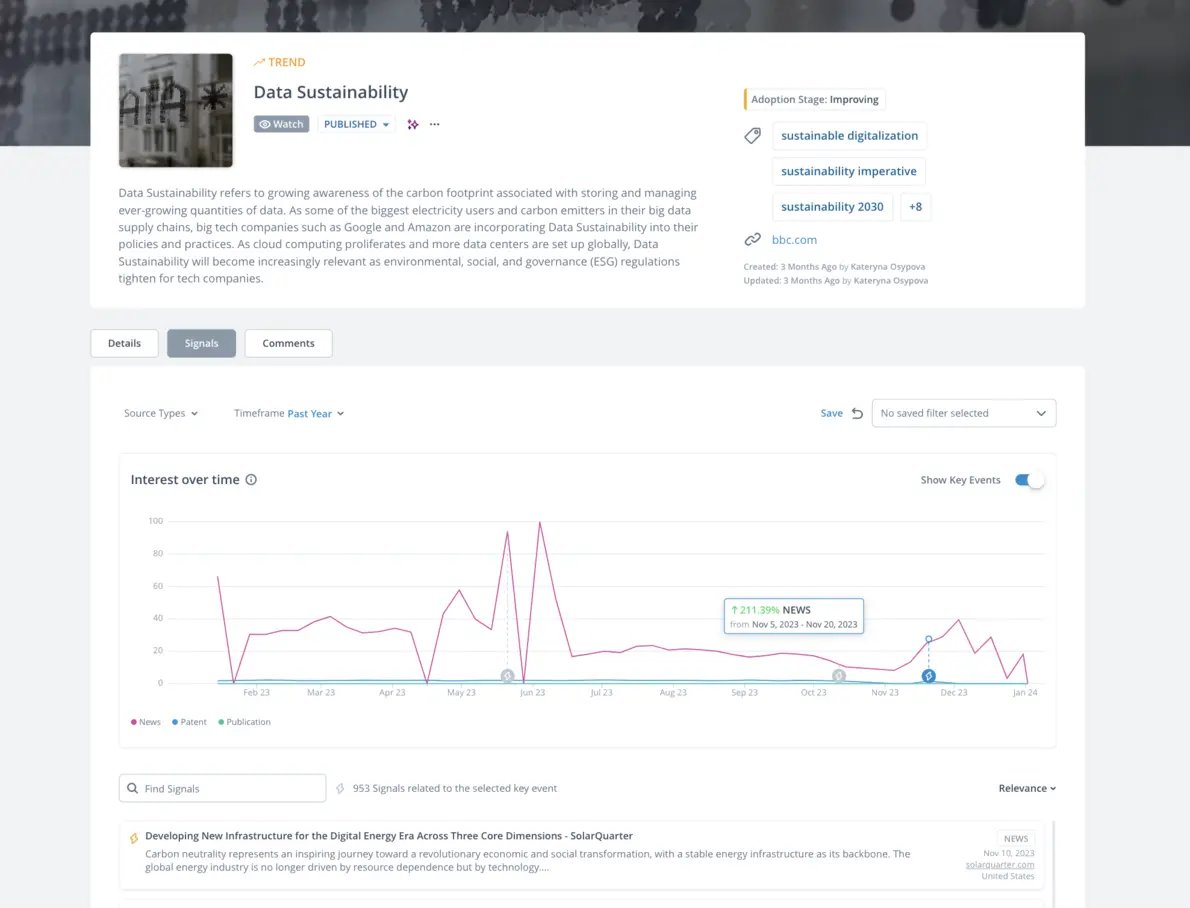
Ricardo Brito, Innovation Lead at Doodle and guest on our Innovation Rockstars podcast, emphasizes the importance of ensuring that innovations address real customer problems and bring tangible value.
Having a good vision is great. Having a good North Star is great. But how much of the things we’re doing actually add value and actually solve a real problem? [...] How many of us actually measure the impact that we have on the customer?
He suggests that businesses should focus on metrics that truly reflect the impact on customers rather than being swayed by industry trends or vanity metrics. This perspective aligns with the principles of customer-centric innovation, where new products are not only technically impressive but also genuinely desired and needed by customers.
9. Emerging technologies
The challenge of managing emerging technologies lies in swiftly identifying, investing in, and integrating new technological advancements into existing business models and processes. This challenge is exemplified by the concept of Martec’s Law. It describes a conundrum where technology changes exponentially while organizations change logarithmically. Essentially, the world is changing faster than most companies are equipped to keep up with.
Tips to stay ahead of technological change and maximize your return on technology investment:
- Continuous tech monitoring: Stay updated with the latest technological advancements by automatically monitoring related signals. AI tools can monitor significant and sustained surges or declines in your tech fields so you can identify opportunities quickly.
- Critical evaluation: Cut through the hype by evaluating each technology's potential impact and relevance to your organization rather than just investing in tech for tech’s sake.
- Effective technology portfolio management: Manage your technology portfolio by ensuring a mix of short-term and long-term technological investments that align with your strategic goals. Regularly review and adjust the portfolio based on evolving trends and business priorities.
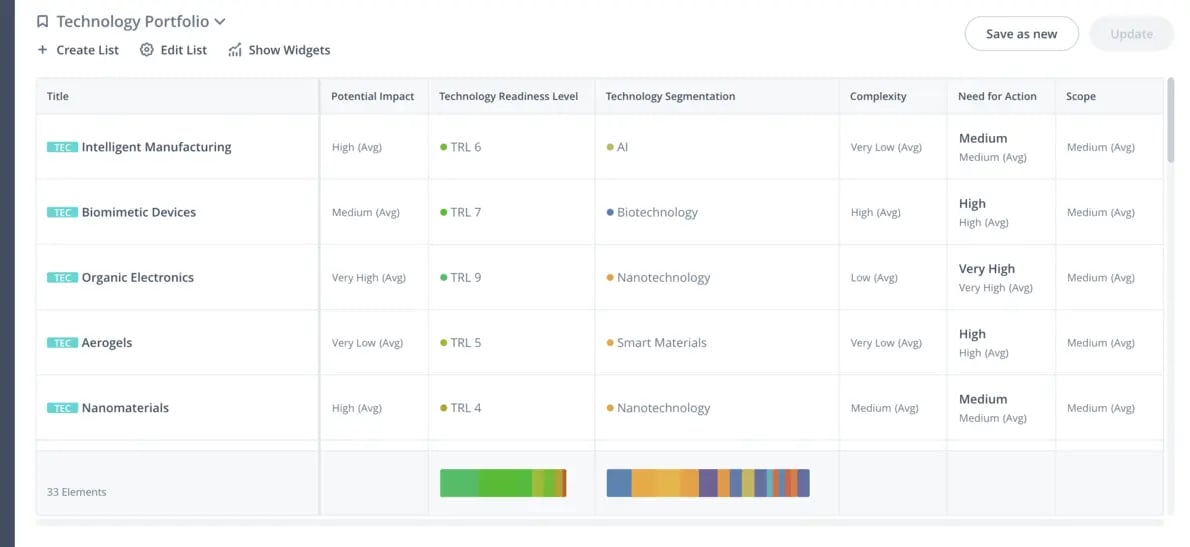
Another pitfall, as pointed out by Hod Fleishman, Partner, VP, Deep Tech Business Innovation at Boston Consulting Group, is the gap between business visionaries, who often propose ambitious ideas not yet feasible with current technology, and engineers focused on the technology itself rather than its business applications.
Sometimes you need business visionaries who say, ‘This thing must be done regardless of whether we have the solution already.’ And other times, you need engineers who say, ‘Here is something very significant we can develop right now; we don't know yet exactly which business case it's going to serve, but it's such a cool technology that we have to pursue it.
In our Innovation Rockstars podcast, Fleishman emphasizes the need to bridge this divide by aligning technological advancements with viable business strategies and developing market-ready innovations that are both innovative and commercially feasible. This involves finding a middle ground that combines the visionary ideas of business leaders with the realistic possibilities offered by emerging technologies.
10. AI integration
Finally, the most buzz-worthy challenge on this list: integrating AI into business operations and innovation processes. The emergence of the AI application layer and meteoric rise of GenAI are rapidly transforming all industries. But for many companies, jumping on the proverbial bandwagon when it comes to hyped-up technologies can lead to poorly executed projects and minimal returns on investment. Gartner predicts that by 2025, growth in 90% of GenAI deployments at the enterprise level will slow as the costs of implementation exceed value creation.
Tips to maximize your return on AI innovation investment:
- Adopt a holistic approach: Implement a comprehensive operating system for managing innovation, ensuring AI initiatives align with your company's overall strategy and portfolio of existing initiatives.
- Systematize AI integration: Create structured processes for AI adoption, focusing on scalability, viability, and integration within your existing business operations.
- Focus on value creation: Select AI projects that add tangible value tailored to specific business needs. Measure their impact using KPIs to assess ROI and impact on your business's overall objectives.
Daria (Dasha) Krivonos, CEO of the Copenhagen Institute for Futures Studies, shares her thoughts on the future of AI in our Innovation Rockstars podcast. While she thinks AI is many things—hyped up, divisive, a game-changer—she also thinks its potential for positive change is still underestimated.
While we're discussing [AI] as a fascinating technology, we're failing to think through the ultimate impact it might have on who we are, our way of life, and we're missing a golden opportunity to steer it for the better.
Daria (Dasha) Krivonos, Copenhagen Institute for Futures Studies
Steering AI in the right direction—for society, for business—requires a holistic, systematic, and value-focused approach to innovation. With the ITONICS Innovation OS, your team can align its AI ventures with strategic goals, market needs, and existing portfolio initiatives. The Innovation OS ensures that new ventures are systematically evaluated, validated, and executed so that AI becomes the true game-changer it promises.
Tackle innovation challenges with ITONICS
To effectively mitigate these challenges and complexities in innovation, ITONICS offers comprehensive, fully configurable, and AI-driven innovation management software. The ITONICS Innovation OS centralizes, aligns, and streamlines end-to-end innovation activities from strategy to execution.
To find out how world-leading companies overcome these common innovation challenges by using the #1 innovation operating system, book a free demo today!










